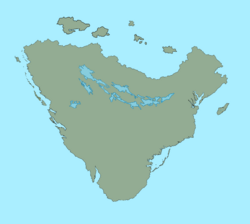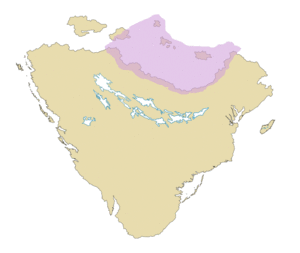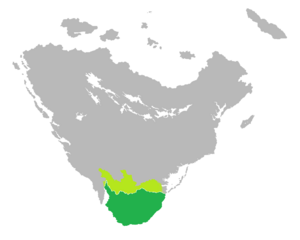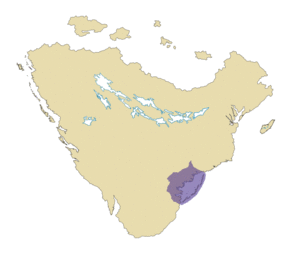Great Kirav: Difference between revisions
Carthinova (talk | contribs) |
m Pelerin Mountains |
||
| Line 184: | Line 184: | ||
[[File:Dobri dol.jpg|thumb|idj]] | [[File:Dobri dol.jpg|thumb|idj]] | ||
[[File:Bad kleinkirchheim.jpg|thumb|idk]] | [[File:Bad kleinkirchheim.jpg|thumb|idk]] | ||
The Eastern Highlands (Kiravic: ''Érþaixtihoma'') cultural region encompasses the Aterandic Mountains, their foothills, and some adjacent lowland areas. | The Eastern Highlands (Kiravic: ''Érþaixtihoma'') cultural region encompasses the [[Aterandic Mountains|Aterandic]] and [[Pelerin Mountains|Pelerin Mountains]], their foothills and valleys, and some adjacent lowland areas (the ''ápihoma Pelerisk''). | ||
Settled by groups of Coscivians (especially Ĥeiran Coscivians), Gaels, and Prythons who intermarried extensively with the local aboriginal population... | Settled by groups of Coscivians (especially Ĥeiran Coscivians), Gaels, and Prythons who intermarried extensively with the local aboriginal population... | ||
Revision as of 23:30, 1 January 2025
 | |
| Area | 10,801,735 km² |
|---|---|
| Population | 1.4 billion |
| Population density | 953.55 |
| Demonym | Kiravite, Great Kiravian |
| Countries | |
| Time zones | Valēka Standard Time (IST -0:30) |
| Internet TLD | .gk |
| Largest cities | Valēka Saar-Silverda Escarda |
Great Kirav (Kiravic: Ambrix Kirav, Ambrikirav) is an island continent, situated in the northeast of the Odoneru Ocean, northwest of Levantia, from which it is separated by the Kilikas Sea. The entirety of its landmass is governed by the Kiravian Federacy, a pluricontinental federation of which Great Kirav constitutes the historic, cultural, and economic heartland.
Terminology
Until the latter half of the ʀw20700s, the island continent was simply referred to as Kirav (or local equivalents, see below) in ordinary speech. The adjective Ambrix ("great", "noble") had been attached to Kirav as a poetic honorific since the Third Empire, but did not enter common usage until Kiravian overseas expansion made it more frequently necessary to distinguish the island continent from the whole of the growing Kiravian realm. The adoption of 'Great' was also driven by the concurrent cultural zeitgeist in the coastal states, which embraced the nation's rise as a major power with imperial ambitions.
The ultimate etymology of Kirav is not definitively known. The theory with the most credibility among Occidental linguists traces it to the reconstructed Proto-Kasavic *ḱʏdɮ, other descendants of which include the Kiravic Kūla ("planet Earth"), and the Æonaran Coscivian śad (" land"), and the leading minority theory traces it to *sḱəgʷʰ, believed to be the endonym of the primordial Kasavic peoples for themselves. However, neither of these proposed etymologies has widespread acceptance among Coscivian dark philologists, most of whom reject them as a superposition of Levanto-Sarpic thought patterns onto primitive Kiravian history, incongruent with attested patterns of semantic relationships between analogous words in later languages and unlikely given what is known about the cosmology and self-conceptions of the Kasavs. Some believe that academia is barking up the wrong tree entirely, and that the kir root is ultimately of Urom origin.
Residents of Great Kirav are usually called Kiravites (Kiravic: Kiraviēxtya) rather than Great Kiravians, though the latter term has seen some use. People from Great Kirav who no longer live there, especially first-generation colonists in the Federacy's overseas possessions, are called Kiraviēþûrix ("Kiravborn") or iodevahomax ("islocontinental").
Kiravians often refer to Grat Kirav as iodevahoma ("the island-continent"), hátihoma ("the mainland"), or atómihoma ("the homeland").
In modern scientific/geographic and cultural/political contexts, the term "Great Kirav" is understood to include adjacent islands such as Ixikéa, Ilánova, and Rhuon, and to exclude Koskenkorva.
Geoschemes
The question of where Great Kirav belongs in various divisions of Ixnay into continent-based regions has two main answers. The most common perspective among Kiravians is that Great Kirav is an island continent unto itself and does not properly belong to any wider continent-level region. Most world maps and globes produced for the Kiravian market reflect this understanding. However, Occidental geographers have long classified Great Kirav, together with the Arctic and smaller islands in the general neighbourhood, as part of a continent-level division known as Arcto-Kiravia or Kiroborea. The Kiravian government has welcomed and increasingly promoted the notion of a Kiroboreal or Arcto-Kiravian region in modern times, viewing it as useful for maintaining strong diplomatic and economic ties to other boreal countries and legitimising its projection of power into the Arctic.
Geography

Great Kirav is an island continent located in the upper temperate latitudes of Ixnay. Temperate mixed forest and Coniferous forest are the native vegetation across most of the landmass, though extensive areas have been cleared for cultivation over the centuries.
Topography
Topographically, key features of Great Kirav include...
The upper interior plateau of Great Kirav was heavily glaciated during the last glacial maximum, with the retreating glaciers leaving an abundance of lakes in their wake. The largest of these lakes form an arc across the upper-middle latitudes of the continent between the Eastern and Western Highlands, known internationally as the Great Kiravian Lake Belt and domestically as the Fresh Seas (Miśnafara).

Climate
Great Kirav and its associated islands have a varied but thoroughly temperate climate spanning a several gradations of temperature, moisture, and continentality and incorporating many localised microclimates of ecological and agricultural significane produced by the interactions of oceanic and atmospheric currents with the continent's varied topography. The West Coast and most of South Kirav experience a moist, oceanic climate spanning a wide range of thermotypes from lower mesotemperate (verging on thermotemperate) in Xula and Argévia northward to upper themoboreal and subpolar oceanic in Lataskia. Ample precipitation in these regions is conducive to the growth of temperate rainforests in many areas. The North Coast and the two western Coscivian Sea islands, Rhuon and Geoff, experience a subpolar oceanic climate, whereas the more easterly islands, such as Tharvia, have boreal subcontinental climates ranging from mesoboreal through supraboreal to oroboreal in terms of thermal gradations. The inland extent of these oceanic zones is obstructed by the Western Highlands in the west and the Ximantav Mountains in the north, giving the remainder of Great Kirav (the eastern seaboard and the vast interior) a more continental (though still generally humid) climatic profile, broadly subdivisible into a mesotemperate nemoral zone in the south, a supratemperate mixed-forest laurentian zone in the middle latitudes, and a hemiboreal zone extending across Upper Kirav and adjacent regions. Weather patterns in the Kiravian interior are further influenced by the Fresh Seas (a longitudinally-distributed belt of lakes separating the hemiboreal and laurentian zones) and by the hilly terrain of the south-central region. Inland regions closer to the major mountain ranges and falling within their rain shadow are much drier than the eastern seaboard and lakeside areas. Altitudinal and orographic factors shape the complex climatic profile of the highland regions themselves, which at their extremes support oroboreal and cryoroboreal climates where the lowest temperatures on the mainland have been recorded.
Administrative Divisions
Great Kirav does not correspond to a specific political entity within the Kiravian Federacy. All federal subjects located on Great Kirav and the adjacent islands are, together with Koskenkorva and Æonara, part of the Kiravian Federation or 'Inner Federation', a theme of the Kiravian Federacy. References to "Great Kirav" in Kiravian law since Kirosocialism are understood to include all of the adjacent islands, while older references are understood to exclude Ilánova unless otherwise specified. References to the "Home Islands" include Great Kirav, its outlying islands, Ilánova, Koskenkorva, and the Coscivian Sea islands.
In the framework of administrative-territorial formations, Great Kirav comprises X states ("inner states"), Y territories ("inner territories"), and two Federal Districts.
[Table of federal subjects here]
Languages
There are several language families native to Great Kirav. At present, there is no demonstrable genetic relationship between the top-level groupings listed here, though ancestral connexions of great time depth have been hypothesised. Some Coscivian linguists have classified Kiravian language families into three groups - Itaho-Atrassic, Macro-Koskenkorvan, and Demomappic - mainly on non-linguistic grounds such as common origin myths, folk-religious rituals, and phrenological similarities of modern speech communities. This classification scheme is not entertained in the Occident, but international academics have nonetheless adopted the aforementioned threefold classification for convenience, under the terms Atrassic, Neo-Kiravian, and Palæo-Kiravian. Occidental linguists generally presume, based on non-linguistic evidence of ancient migrations, that all of the indigenous languages of Great Kirav must ultimately descend from at most[1] two proto-languages: Proto-Kiravian (ancestral to the Neo-Kiravian and Palæo-Kiravian languages) spoken by Ice Age migrants from Levantia, and Proto-Atrassic spoken by Neolithic seafaring migrants of Audonian-Cronan origin. In Coscivian academia, no such presumption is made, and Palæo-Kiravian is treated as a paraphyletic or polyphyletic group.
The threefold classification of indigenous Kiravian languages is presented below:
- Neo-Kiravian or Macro-Koskenkorvan
- Cosco-Adratic languages
- Adratic branch: Classical Adratic†, Modern Adratic
- Kasavic branch: Kironic (e.g. Kiravic Coscivian and Korlan), Striburyan, and Xarbasurian clades
- Eridanic branch
- Ixtoric languages: High Coscivian, Sʑvoʎatellic†, Costratic languages (descended from High Coscivian)
- Ensciryan languages: Ĥeiran A, Ĥeiran B, Phrydhian Coscivian, Old Suderavic
- Heronic languages: Engrian, Iforian, Insdean, Ƕairan, Pine Swamp Coscivian, Arnórian Coscivian (Male)
- Thessapic languages: Eskean, Kalvertan, Eusan
- Cosco-Sēoran languages
- Tholian branch: Antaric, North Coscivian, Kilikas-Valēkas clades; Enurian†, Kapernik-Kapeniak
- Austro-Kiravian branch: South Coscivian, Serradan, Thygiastran†, Fever Swamp Coscivian
- Northeastern languages: Eshavian Coscivian, Arnórian Coscivian (Female), Liśkan, Ebondan, Demarești, Wynntran, Wastani
- Cosco-Adratic languages
- Palæo-Kiravian or Demomappic
- Elutic languages: Ossiryan, Déurian, Ellyrian, Kópistonian
- Intheric languages: Cyptovi, Issantak, Surrian, Qódavan, Rifpito, Xufur-Xafre-Gaur,
- Gascanic languages: Veuskan, Hazléta
- Rulo-Swadeshi languages: Rulote†, Sikuryan, Draili, Skithanawite, Aınaromanote, Durdeshi†
- Itaho-Atrassic or simply Atrassic languages: West Coast Marine Coscivian, Qihuxian Coscivian, Xorsyakavi, Kayaki, Pungōvak, Ūtran
- Unclassified: Kiʞik language (confirmed isolate), Caoi (confirmed isolate), Varekthari (provisional isolate), Hozsyar (possibly spurious), Oklʌsterbé, unnamed mother tongue of Shafto the Wise (unattested).
Kiravian Gaelic, a Levanto-Sarpic language, is the only non-indigenous language with a prolonged historical presence in Great Kirav. Other non-indigenous languages are spoken by communities of modern immigrant origin.
Cultural Regions
Northern Fringe

Also known as the North Coast and the Hockey Belt, the Northern Fringe extends along the Coscivian Sea coast of Great Kirav from Mariava (where it overlaps with Zone B) to Devahoma, and is generally held to extend roughly 2-4 countyships inland along this span, depending on longitude, before merging into the Mid-Continental region. The climate of the North Coast is cold and harsh, classified as cool continental or subarctic in some places and subpolar oceanic in others, particularly islands like Tharvia. The ecologically hemiboreal belt stretching across northern Great Kirav is roughly coëxtensive with the cultural transition zone between the North Coast and Mid-Continental areas.
The long-established Coscivian inhabitants of the Northern Fringe are known as Arnórian Coscivians. Arnórian Coscivians remain the majority or plurality group in most countyships on the Northern Fringe, and residents of other ethnic backgrounds have come to adopt much of Arnórian culture and even partially assimilate into an Arnórian identity.
The traditional language of the region is North Coast Coscivian, also called Arnórian Coscivian. North Coast Coscivian remains the majority language in rural and periurban areas, though Kiravic Coscivian has become the main spoken language in most cities in the region.
Cuisine: Potato, fish, oats Alcohol: Spruce ales, heather ales, whiskey, akvavít, gin
As the climate of the North Coast is not suitable for the cultivation of hops, residents have traditionally flavoured their beer using a variety of other botanicals, most prominently spruce or pine buds and heather. These techniques persisted even after the establishment of reliable trading networks made hops from the southern East Highlands available to North Coast settlements, and the region's spruce and heather ales continue to be produced in the style of the early pioneers.
Upper Kirav
The northernmost region of inland Kirav, bounded by the Lake Belt to the south, Eastern Highlands to the east, and Western Highlands to the West, is known as Upper Kirav. The boundary between Upper Kirav and the Northern Fringe is not precisely defined, and in many non-cultural contexts the Northern Fringe is included in Upper Kirav.
This region has a mainly hemiboreal to mesoboreal climate, and its dominant form of vegetation is boreal forest.
Northeast
The smallest cultural region, encompassing Fariva and Harma (with the exception of Åstor Island), and extending into southeastern Serikorda, the Northeast has its roots in the early Coscivian settlements that took root around Fariva Bay. This region was settled heavily by Eshavian Coscivians, who remain the majority in Harma and rural parts of Fariva and southeast Serikorda, and continue to dominate the region politically and culturally.
Eshavian Coscivian is the traditional and most widely-spoken native language in Andera, although Kiravic has become the main language of interethnic communication in the Bérasar metropolitan area.
Cuisine: Potato, dairy/cream/related products, lots of boilage, seafood Alcohol: Elderberry ale..., cider, whiskey, gin
Mid-Oceanic Kirav
The Mid-Oceanic cultural region extends from southwest Serikorda and Middle Kaviska through Róvidrea and Lower Kaviska, Niyaska, Etivéra, and Váuadra, down to the northern fringes of Hanoram in the south. It is bounded by the Eastern Highlands to the west and the sea to the East; corresponding to the core territory controlled by the United Provinces during the Viceregal Period. It encompasses the Valēka Metropolitan Area (Kiravia's largest), as well as the Eriadun Metropolitan Area and numerous smaller cities. The Mid-Oceanic is the cradle of the Kiravic Coscivian language, and dialects of Kiravic are the main language throughout this region, though there are substantial communities speaking other Coscivian vernacular languages and Celtic languages.
Investor-farmer class
Alcohol: Porters and stouts
Mid-Continental Kirav
The Mid-Continental region stretches across most of northern inland Kirav, bordering the Eastern Highlands to its east and the Northern Fringe to its north, and blending into the Northwestern region and vaguely-defined Central Kirav at its western and southern edges.
Mid-Continental Kirav was settled by pioneers hailing primarily from the Mid-Oceanic region during the Ētrebiktor, as well as Great Crossing era Coscivian immigrants of various ethnicities.
Midlands
Various dialects of Kiravic Coscivian are the predominant language throughout Mid-Continental Kirav.
Alcohol: Red ales, pale ales, whole bunch of others
Farravonia
Farravonia encompasses the three states that were once departments of Farravonian League: Cascada, Ilfenóra, and Metrea, Argévia and the southern half of Venèra.
The most spoken languages in Greater Farravonia are the West Coast Marine Coscivian dialect continuüm, which is spoken by communities near the ocean and in the Coastal Ranges, and Serradan Coscivian, which is spoken in the areas between the Coast Ranges and the Western Highlands. Kiravic Coscivian is the main language of daily life in most large urban areas, though use of the two regional languages remains robust in many smaller cities and large towns.
Zone F - West-by-Northwest
WNW Great Kirav is bounded roughly by the Swadesh River in the east - where it blends into Mid-Continental Kirav, the Miradèt Desert in the South, and the Western Highlands in the west. It is divisible into three subregions: The Far Northwest, Insular Northwest, and the Premontane West.
Significant cities in WNW Kirav include Kilgariv, Peśara, Tetraliþa, and Togistàra.
South Kirav

South Kirav is one of the most distinctive cultural and geographic regions of Great Kirav, with a very strong regional identity and well-defined culture. Due to its more level terrain and warmer climate (thermotemperate to lower mesotemperate), South Kirav has long been the country's breadbasket. South Kiravian society is agrarian and traditional, and has been described as "pre-modern" or even "quasi-feudal" in many respects.
Due to a number of factors, most prominently flatter topography and the deterring and levelling effects of its systems of land tenure and labour relations, there has historically been relatively little migration into South Kirav. Ethno-linguistically the South is much more homogeneous than other regions of Great Kirav, and its resident ethno-linguistic groups tend to have quite ancient roots in the areas they currently inhabit and strong connexions to their land. Nonetheless, there are lower-order tuva and subgroups within the areal South Kiravian peoples, often associated with particular regions, occupational roles in the traditional agrarian economy, distant ethnic origins, or religious/sectarian affiliations.

South Kiravian cuisine is often regarded as superior to cooking styles from other parts of the island continent, even by many residents of said other regions, due to its greater diversity of ingredients and richer flavours. Coscivian-Caphirian cuisine is derived primarily from South Kiravian cuisine.
In addition to fieldball (or "Kiravian-rules football"), which is shared with he rest of the Federacy and is wildly popular in the South (especially at the collegiate, minor-league, and semi-pro levels, as most major professional teams are located in Northern, Eastern, and Western cities), South Kiravians have taken up Urcean sports such as baseball and basketball. However, South Kirav is most notable for its interest in a variety of "country sports", many of which have pre-modern, feudal/aristocratic, agricultural, and rural/folk associations. These include archery and other hunting-related sports, horsemanship, jousting and other combat sports, cheese-rolling, and cornhole. The South has a much stronger bench in such sports than other parts of the Federacy, and athletes representing Kiravia in international competitions for these sports are usually either Southerners or Southern-trained.
Many Hekuvian Coscivians, especially those descended from earlier waves of Coscivian migration to Caphiria, trace their ancestral roots to South Kirav. In recognition of this, Hekuvian Coscivians often refer to themselves as Déśkéx Kiravikuya ("Southern-er Kiravians"), the comparative form of Déśkix Kiravikuya ("Southern Kiravians"). Hekuvian Coscivian writers have often noted similarities between the highly stratified, class-conscious, and aristocratic characteristics of South Kiravian society and that of Caphiravian society.
Baylands

The Baylands (Montahomara) or Míhanska Bay region comprises the non-highland areas of Hanoram and Ventarya, as well as northern and eastern Trinatria. Historically, the District of Ksoīnvra also had a Míhanska Bay culture, but mass migration to the Federal capital has left Kartika with a unique blend of cultural influences, among which Mid-Oceanic, Mid-Continental, and Farravonian mores overshadow those of the Mínhanska Bay.
Kalvertan Coscivian is the regional lingua franca of the Baylands. Originating as the vernacular of the Kalvertans, the traditional inhabitants of the Bay Islands, Kalvertan was spread throughout the region as a trade language during the XXth century CC due to the extensive mercantile and nautical activities of its original people, eventually displacing the Vexin Coscivian of the manorial elite castes as the region's most widely spoken tongue.
The brewing and distilling culture of the Bay States has largely converged with that of the Mid-Oceanic and Mid-Continental regions, though Míhanska Bay remains known for its session ales and saisons derived from the styles of traditional farmhouse ales brewed in the region's rural households for many centuries.
The largest cities in the Baylands are Primóra, Kartika, Telmar, and Deneva.
Eastern Highlands


The Eastern Highlands (Kiravic: Érþaixtihoma) cultural region encompasses the Aterandic and Pelerin Mountains, their foothills and valleys, and some adjacent lowland areas (the ápihoma Pelerisk).
Settled by groups of Coscivians (especially Ĥeiran Coscivians), Gaels, and Prythons who intermarried extensively with the local aboriginal population...
During the later colonial period and the viceregal period, the Eastern Highlands - even those parts formally within the borders of established Cosco-Kiravian states or Gaelic kingdoms - remained largely outside the control of any lowland government. Instead, political order was provided by a complex and often overlapping assortment of chiefdoms, clan- and tribe-based polities, self-governing direct-democratic villages, and small mountaineer republics. This long history of self-reliance and independence from central authorities has engendered a lasting libertarian political streak in the region's culture.
The Eastern Highlands also have a strong penchant for religious independence. Excepting the Insular Apostolic Church, which is the largest individual denomination in most East Highland areas, the major Christian churches dominant in other parts of Great Kirav (e.g. Roman Catholic, Coscivian Orthodox) are markedly less influential in the Highlands. Instead, the Highlands are home to a number of more congregational and connexional denominations, such as the Discipular Church and the Mountain Quakers in Íarthakelva state, informal house churches and "clearing churches" without any organisational structure, and a large number of heterodox sects, many of which are considered outright heretical by mainstream churches. Some of the more notable heterodox denominations include the Catholic-Apostolic Church of the Father, Christ, and Melchizadek (Kaþolix-Áspaldix Æglasta Þíarnastursk us Xrístul us Melxisadesk) and the Triclavian Orthodox Church of Ateranda. It is believed that some of the more exotic quasi-Christian sects found in the highlands arose from the syncretism of Christianity with Urom belief systems and the Christianisation of Urom deities.
Western Highlands


Alcohol: Lagers
South-Central Kirav
Also known as 'Deep Inland Kirav', South-Central Kirav is a vaguely defined region that stretches from the southwestern foothills of the Aterandic Mountains to the Miradèt Desert along its east-west axis, extending from southern Kannur and Avidrona in the north to the northernmost peripheries of Andrēdan, Issyria, Xula, and Korlēdan in the south. It blends into and overlaps heavily with South Kirav, Mid-Continental Kirav, and the Premontane West, so much that Kiravians do not consider South-Central Kirav a true cultural region in its own right, and it is often omitted from books and papers on this topic. Yet residents of the region insist that
South-Central Kirav has a large Urom population, as well as many Coscivians with substantial Urom ancestry. Some of the largest Urom tribes, including the X, Y, and Z, are native to the area, and Urom influence on the culture of the region at large is conspicuous.
South-Central Kirav is a stronghold of adherence to the Discipular Church, a medium-seized apostolic Christian denomination with a Reconstructionist orientation and connexionalist polity that seeks to emulate what it believes are the authentic ethos and practices of the early Church. Although the movement originated in Ateranda, it spread most successfully in South-Central Kirav, and proponents of South-Central as a distinct region often point to the distribution patterns of Discipular congregations in their efforts to define the region's extent. The Discipular Church is not, however, the majority or even plurality faith in the region. Coscivian Orthodoxy is the main Christian denomination, and in addition to the Discipular Church a number of other Sectarian churches are also present. There are markedly fewer Roman Catholics and Insular Apostolics in South-Central than in other regions of the country. Followers of Coscivian religions, particularly Sarostivism, are a significant minority, and there is considerable syncretism between Coscivian Orthodoxy, Coscivian religions, and diverse folk traditions in the area.
Landlocked, thinly populated, and endowed with comparatively few natural resources, South-Central Kirav is economically underdeveloped. Lack of transport and communications infrastructure has been a major impediment to development. According to a Ykrān State University study, only 42% of rural households in four South-Central states and territories had access to the internet in 21204, with nearly all using dialup connexions. The region's economy is primarily agricultural.
Border Cities
- Bérasar - Far Northeast and Mid-Oceanic
- Escarda - Mid-Continental and North Coast
- Primóra? - Mid-Oceanic and Míhanska Bay
- [City in Arkvera] - Mid-Continental and Eastern Highlands.
- Sarukon' - South Kirav and Western Highlands
See also
- ↑ The theory of an extra-continental origin of the Proto-Atrassic speakers underpinning the cladistic independence of Atrassic is itself controversial, and many Occidental linguists are inclined toward a monogenetic hypothesis in which all Kiravian languages descend from a single Ice Age ancestor.